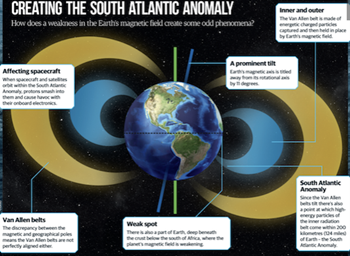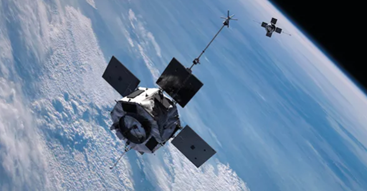by Rida Fatima

(Figure 1: Secrets of the Bermuda Triangle. https://indianexpress.com/article/entertainment/television/secrets-of-the-bermuda-triangle-review-bbc-documentary-series-5875568/)
For years, many cases of mysterious disappearances in the Bermuda Triangle, a region of the North Atlantic Ocean, have come to light. Since the middle of the 19th century, more than 50 ships and 20 aircraft have disappeared without a trace. However, that does not imply that the search for an explanation has not been entertaining. Maybe there are some extraterrestrial beings involved, something is tugging things under the sea, perhaps there is a connection to the storied lost city of Atlantis. It can also be just bad weather leading to a human error, or a lot of traffic in the area? In reality, there aren’t any more disappearances in this part of the ocean than in any other well-traveled region, yet conspiracy theories still abound. From space, we can investigate a similar phenomenon known as the “Bermuda Triangle of space”. This region above the Earth is known to cause trouble for any spacecraft that happens to pass through it. No one is saying that the ships in question are suddenly dissipating into thin air, but the disturbance nonetheless poses severe issues for both the astronauts’ equipment and safety (Crookes, 2020).
WHERE IS THE SOUTH ATLANTIC ANOMALY?
The South Atlantic Anomaly (SAA), sometimes known as the Bermuda Triangle of Space, is located above the South Atlantic and stretches from Chile to Zimbabwe. It’s located where the inner Van Allen radiation belt is most in close proximity to the planet’s surface. The magnetic field of Earth is very weak here. In order to better understand, let’s look at Earth’s two Van Allen belts, which are magnetically locked rings of charged particles that circle our globe. High-energy protons make up the majority of the inner half, while electrons make up the majority of the outer part. The belts end up shielding the planet’s surface from dangerous radiation because they catch the particles that are firing from the sun’s surface.

(Figure 2: How the South Atlantic Anomaly (SAA) is created. https://www.space.com/bermuda-triangle-in-space.html45S_9aP7AhVfhP0HHRptDz0Q_AUoAXoECAEQAw&biw=1366&bih=657&dpr=1)
However, the solar cosmic ray particles are not being repelled to the same degree at the SAA position as they are elsewhere above the globe. As a result, the distance between the sun’s rays and the Earth’s surface is reduced to 200 kilometers (124 miles), and the region experiences an increase in the flux of energetic particles due to the sun’s stronger radiation. The lower geomagnetic field intensity in that location eventually makes satellites there more susceptible to energetic particles, to the point that spacecraft damage could happen when they pass through the zone (Keating, 2018). Due to the decreasing magnetic field intensity, the inner Van Allen radiation belt, or Earth’s radiation belt, is able to approach the planet’s surface, which causes issues with communications satellites and other equipment.
According to a researcher, satellites travelling through this area will be exposed to greater radiation levels to the point where damage may result. “Imagine a discharge or arc in an electrical system. A satellite may become charged as a result of increased radiation arriving, and the ensuing arcs may cause significant harm.
WHAT HAPPENS TO SPACECRAFT AND ASTRONAUTS IN THE SOUTH ATLANTIC ANOMALY?
Due to the decreasing magnetic field intensity, the inner Van Allen radiation belt, or Earth’s radiation belt, is able to approach the planet’s surface, which causes issues with communications satellites and other equip. According to a study, satellites travelling through this area will be exposed to greater radiation levels to the point where damage may result. “Imagine a discharge or arc in an electrical system. A satellite may become charged as a result of increased radiation arriving, and the ensuing arcs may cause significant harm. Shutdowns protect a number of significant operations, such as those employing the Hubble Space Telescope, which travels through the SAA ten times per day and spends about 15% of its time there. Unfortunately, but necessary, Hubble cannot gather astronomical data at these times. System failure is probably what would happen if measures weren’t taken. Undoubtedly, there is a greater chance for issues to arise the more complicated electronics have grown. For instance, the onboard oscillator frequency shifts for satellites using the microwave tracking method DORIS, which stands for Doppler Orbitography and Radiopositioning Integrated by Satellite (Aron, 2014).

(Figure 3: The Van Allen Probes (VAP) were launched in 2012 and operated for seven years to better understand Earth’s radiation belts. https://www.nasa.gov/mission_pages/rbsp/mission/index.html)
Computer issues on board spacecraft that pass by the SAA have also been observed by astronauts. “Putting equipment into a safe mode” involves restricting operations that are more radiation-sensitive. In fact, the SAA is the reason that the International Space Station (ISS) has robust shielding around the areas that are used the most, such the gallery and the sleeping areas, limiting the radiation the astronauts are exposed to. Additionally, it explains why astronauts are required to wear dosimeters, which monitor an individual’s exposure to ionising radiation in real time and issue alerts when harmful levels are reached.
WHAT CAUSES THE SOUTH ATLANTIC ANOMALY?
The weak magnetic field above the South Atlantic is a result of Earth’s irregular shape, which is not entirely round. The Earth’s magnetic dipole field is located approximately 300 miles (500 km) away from the planet’s center due to a modest middle bulge (300 miles). Charged particles and cosmic rays are fairly close to the Earth’s surface. They provide minimal protection from interplanetary space where the dip is located. The magnetic bubble still blocks the surface from the solar wind, though.
The magnetic field is maintained by a dynamo mechanism that rises up from the fluidized metal in the Earth’s outer core, producing electric currents. The tumultuous movement of molten, charged material as the globe rotates on its axis creates the magnetic field that gives the planet its north and south poles at the surface. The Earth’s magnetic field, however, is continually moving and changing strength, thus the poles aren’t fixed. The SAA is currently expanding because the magnetic field is diminishing in that region (ESA, 2020).
NASA is actively investigating. Ionospheric Connection Explorer was orbited by a Northrop Grumman Pegasus XL rocket on October 10, 2019. Its mission-required monitoring of the weak region in the magnetic field revealed that the “dent” in the magnetic field is basically travelling west and dividing in two. NASA reported that this is making satellite missions more difficult. Terry Sabaka is a geophysicist at NASA’s Goddard Space Flight Center in Maryland, according to Terry,
“The SAA is slow-moving but it is undergoing some change in morphology, so it’s also important that we keep observing it by having continued missions because that’s what helps us make models and predictions.”
References
- Crookes. (2020, July). South Atlantic Anomaly: Have astronomers finally explained space’s Bermuda Triangle? Space.com. Retrieved November 2022, from https://www.space.com/bermuda-triangle-in-space.html
- Keating. (2018, February). What it’s like in the Bermuda Triangle of space. What It’s Like in the Bermuda Triangle of Space – BBC Future. Retrieved November 2022, from https://www.bbc.com/future/article/20180208-what-its-like-in-the-bermuda-triangle-of-space
- Aron, J, New Scientist, “Dead spacecraft helps map Bermuda Triangle of Space” May 21, 2014. https://www.newscientist.com/article/dn25600-dead-spacecraft-helps-map-bermuda-triangle-of-space/?ignored=irrelevant#.U4PN8PldV8H
- ESA,“Our.protective.shield”. http://www.esa.int/Applications/Observing_the_Earth/Swarm/Ourprotective_shield
